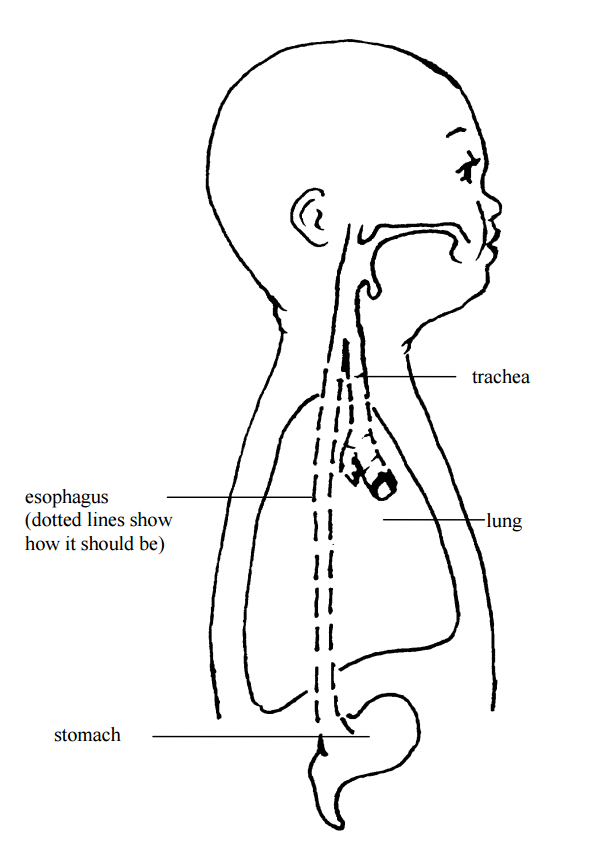Tracheoesophageal fistula
What is tracheoesophageal fistula?
Tracheoesophageal fistula (tra-kee-o-ee-sof- a-jee-al fis-tu-la), also called TEF, is an abnormal opening between the trachea (windpipe) and the esophagus (tube from the mouth to the stomach) that results from these two structures not forming separately.

Your baby may also have esophageal atresia (ee-sof-a-jee-al a-tree-zee-a), meaning the esophagus does not develop all the way to
the stomach but ends as a pouch in the upper chest. Ask your doctor to draw on this picture, to show you your baby's condition.
How is the diagnosis made?
Signs of both conditions are:
- large amounts of saliva.
- trouble swallowing saliva .
- choking or coughing when being fed.
If these signs are present, a radiopaque tube (one that appears as a light area on the X-ray) is put gently down the esophagus and X-rays of the chest are taken. The X-ray shows where the esophagus ends.
What is the treatment?
Most problems will be corrected in one surgery, but sometimes two or more operations are needed.
The surgery may not be done right away. The surgeons will need to evaluate the best way to correct the problem. Some babies need to grow before surgery.
Before surgery, your baby will be cared for in the neonatal intensive care unit (NICU) or infant care center (ICC). Sometimes a ventilator (breathing machine) may be used to help your baby breathe and a suction tube may be needed in the esophagus to keep secretions from going down the trachea.
Your baby will have an intravenous (IV) line to provide fluids and nutrition. IV antibiotics may be needed to prevent infection. Some babies need a gastrostomy tube (tube into the stomach) for feedings.
What can I expect after surgery?
After surgery, many babies are on the ventilator and get their fluids, pain medicine, and nutrition by IV. Most babies will have a chest tube (a tube inserted through the skin into the baby's chest wall) to help keep the lungs open and free of fluids that might collect after surgery.
The doctors and nurses will watch for these complications:
- trouble breathing.
- Infection.
- problems with the chest tube.
- leaking or narrowing where the trachea or esophagus are sewn.
- unstable temperature.
Your baby will stay in the NICU until stable.
How can I care for my baby?
You can be involved in your baby's care right away! This could include changing the diaper, taking the temperature, or comforting your baby by talking softly or singing. Both you and your baby can enjoy and benefit from holding when your baby is ready. As always, be sure to wash your hands well before and after touching your baby.
Questions?
This sheet is not specific to your baby but provides general information. If you have any questions, please ask the nurse or doctor.
Children's Hospitals and Clinics of Minnesota
Patient/Family Education
2525 Chicago Avenue South
Minneapolis, MN 55404
Last Reviewed 7/2015 © Copyright
This page is not specific to your child, but provides general information on the topic above. If you have any questions, please call your clinic. For more reading material about this and other health topics, please call or visit Children's Minnesota Family Resource Center library, or visit www.childrensmn.org/educationmaterials.
© 2024 Children's Minnesota
